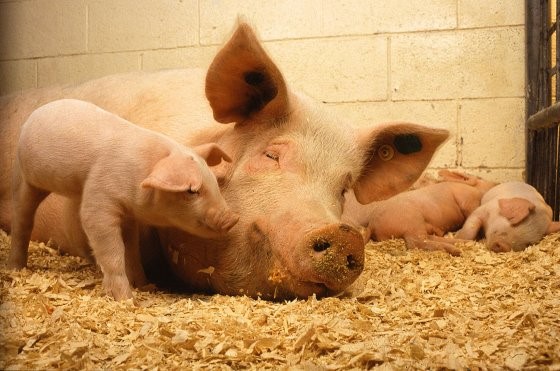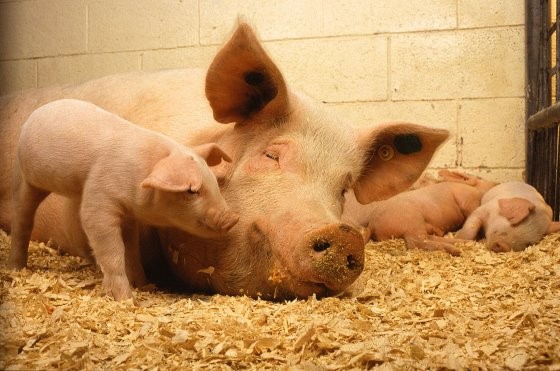The role of bile acids in sow and piglet nutrition

Bile acids plays an important role in animal husbandry, such as promoting the digestion and absorption of fat and fat-soluble substances, saving energy, promoting animal growth, improving carcass quality, preventing and treating liver and gallbladder diseases.
The key to the profitability of pig farms lies in the level of sow and piglet management, and the value of sow is mainly reflected by piglets. Therefore, the industry puts forward the concept of sow andpigletintegration (SPI) nutrition from the perspective of systematic nutrition programme. The application effect of bile acids in sow and piglet feed is reviewed in this article.

Common problems in sows and piglets
In the processof large-scale and intensive breeding, farmers will face the following problems of sows and piglets:old skin, rust lines, dull colour of piglets’ skin and fur, etc.
Common sow reproductive performance and production problems such as:low feed intake,constipation,mastitis,low milk yield,piglet low intake,high diarrhoea rate,low birth weight and weaned weight,growth retardation,higher feed conversion ratio, etc.
Which are confronted by feed and farming corporations around the world.
It was found that the common problems of sows and piglets were related to:physiology,pathology,feed,environment,stress and autoimmunity.
Lactating sows have:lacrimal blotches,rust-coloured bleeding on the back,dull coloured skin and fur and other problems, which are often related to the accumulation of toxins in sows’ bodies and the impaired ability of liver detoxification.
Implications of weaning stress
Sows cannot excrete toxins from their bodies, on the one hand, the accumulation of toxins in sows bodies causes a large increase in bacterial endotoxin, intestinal microbial imbalance, and continuous constipation. On the other hand, toxins accumulate in piglet bodies through placenta and milk, causing the occurrence of hepatogenic diarrhoea through aggravating the liver damage, reducing secreted bile acid, fat and milk Indigestible absorption.
Weaning piglets from 3 to 4 weeks or even before 3 weeks has been widely used in modern farming. The volume and weight of the piglets digestive tract and digestive gland have not reached maturity level in this stage. Weaning feed structure has changed dramatically, such as DE from 22.18 MJ to 13.8 ~14.5 MJ (in terms of dry matter per kilogram), extremely easy digestion milk transform into indigestion soybean meal contain many antigens and anti-nutrition. Indigestible starch, protein and fats and insufficient digestive enzymes and bile acid cause piglets weaning stress, resulting in intestinal injury, diarrhoea, low feed intake, dulled coat colour, growth retardation, etc.
The physiological function of bile acids
Bile acids, a feed additive, are a steroid-like substance and main organic component of bile. Runeon, a patented functional feed additive of Shandong Longchang Animal Health Products Co. is the main ingredient in bile acids. A current study found that bile acids can promote the absorption of cholesterol, lipids and fat-soluble vitamins in the intestine. In addition, the bile acid is also an important signal regulating molecule, can activate specific nuclear receptors ester X receptor (FXR Farnesoid X receptor), G protein coupled receptors and signalling pathways in liver and gastrointestinal cell, which changes and regulate gene expression for synthesis, metabolism, transport and energy metabolism related enzyme (protein) of bile acid, glucose, fatty acids and lipoprotein.
The main functions of bile acids in animals include:
1.Participating in the digestion and absorption of fats and fat-soluble substances, emulsifying, activating lipase and transporting fatty acids in the process of fat digestion and absorption;
2.Bile acids are mainly found in the enterohepatic circulation system and which promote the excretion of liver and intestinal toxins through recycling to protect the liver and intestinal function;
3.Bile acids in the liver have the function of maintaining cholesterol balance;
4.Bile acid in the intestinal has antibacterial and anti-inflammatory functions.
The effect of bile acids in feed of sow and piglet
Bile acids in sow feed can improve the quality of sow colostrum (reducing cholesterol in colostrum, increasing the content of triglycerides and total protein in colostrum significantly), increasing the weaning weight of piglets significantly, affects the secretion of serum-related hormones in weaned piglets (cortisol levels in serum of weaned piglets are significantly decreased (P < 0.05), and insulin, T3 and T4 levels are significantly increased).
The effect of bile acids to lactating sow diet on biochemical indexes of colostrum
Table 1 shows that triglycerides in the colostrum of the 50 ppm, 100 ppm, 150 ppm, and 200 ppm groups were significantly increased compared with control group (P < 0.05). The total protein in the colostrum of the 100 ppm, 150 ppm, and the 200 ppm in the sow diet supplemented with bile acids was significantly increased compared with the control group(P < 0.05).
Table 1 - Effect of bile acids addition on the biochemical parameters ofcolostrum in sow diet
Note: The data represents the mean ± standard error, and the * in the same row indicates a significant difference (P < 0.05), n = 7(mmoL/L)
Effect of bile acids to lactating sow diet on weaning weight of piglets
Table 2 shows that compared with the control group, the weaning weight of the sow diet with bile acids 100ppm, 150ppm and 200ppm was significantly increased (P < 0.05), and the 50ppm group showed an increasing trend. The results show that the addition of bile acids to the sow diet increased the weight of weaned piglets.
Table 2 - Effect of bile acids to sow diet on weaning weight of piglets
Note: The data represents the mean ± standard error, and the * in the same row indicates a significant difference (P < 0.05), n = 7
Effect of bile acids on the intestinal digestibility of nutrients in weaned piglets
The application of bile acids in piglet feed can improve the growth performance, improve the intestinal digestive rate of nutrients in piglets, and affect the secretion of serum related hormones in piglets. As shown in Table 3, the apparent digestibility of crude protein of weaned piglets in bile acids group was increased compared with the control group. The apparent digestibility and total energy digestibility of crude fat in the 80~100 mg/kg bile acids treatment group were significantly improved, and the apparent digestibility of dry matter was significantly improved.
Table 3 - Effect of bile acids on the apparent intestinal digestibility of nutrients in weaned piglets (%, dry matter basis).
Note: There is a significant difference between the different lowercase letters in the peer data (P <0.05); the absence of a letter or the same letter indicates that the difference is not significant (P >0.05).
Improving sow reproductive performance and piglet growth performance
The addition of bile acids to lactating sow diets increased the content of triglyceride and total protein in colostrum significantly, increased the apparent digestibility of crude protein, crude fat, dry matter and total energy in weaned piglets, and significantly increased the weaning weight of piglets. This is related to bile acids as an important signal-regulating molecule, regulating the physiological functions of synthesis, metabolism, transportation and energy metabolism of glucose, fatty acids and lipoproteins; bile acids involved in the whole process of emulsification, digestion and absorption of fat as a digestive juice.
In addition, bile acids is also an excretory fluid, which is mainly found in the intestinal circulatory system and promotes the excretion of liver and intestinal toxins, antibacterial and anti-inflammatory effects through recycling, thereby achieving the function of protecting the liver and intestinal function.







